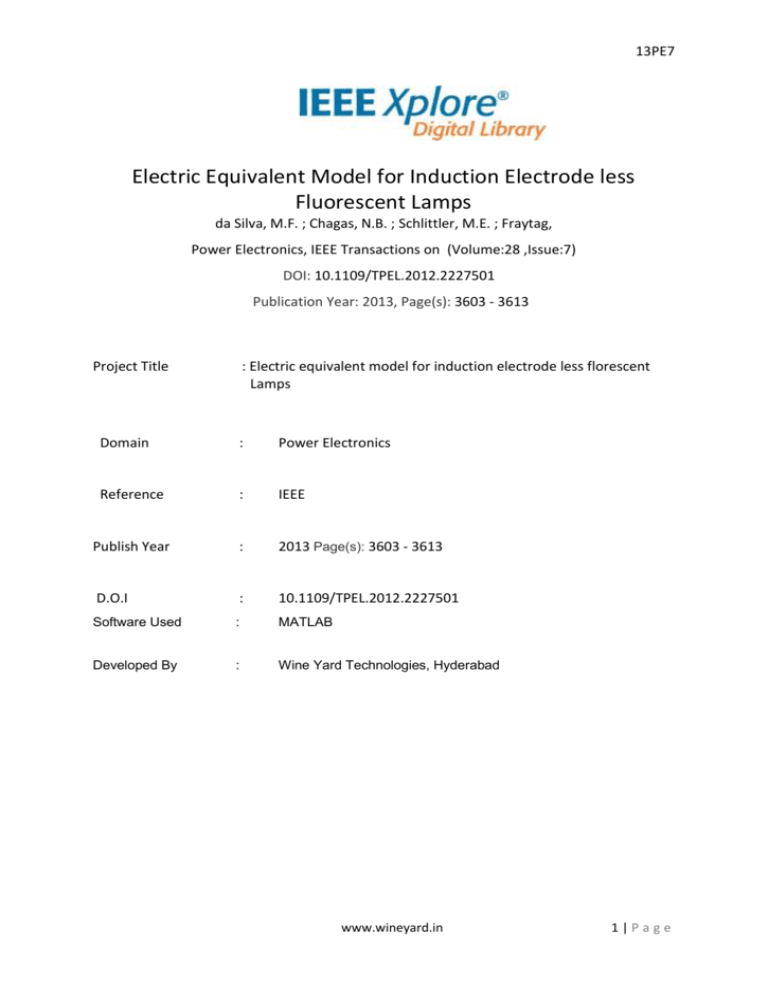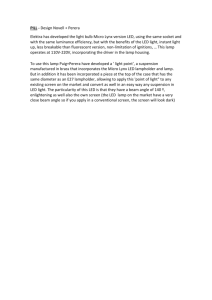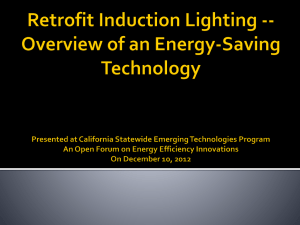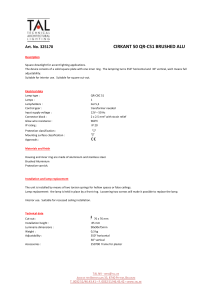13PE7 Electric Equivalent Model for Induction Electrode less
advertisement

13PE7 Electric Equivalent Model for Induction Electrode less Fluorescent Lamps da Silva, M.F. ; Chagas, N.B. ; Schlittler, M.E. ; Fraytag, Power Electronics, IEEE Transactions on (Volume:28 ,Issue:7) DOI: 10.1109/TPEL.2012.2227501 Publication Year: 2013, Page(s): 3603 - 3613 Project Title : Electric equivalent model for induction electrode less florescent Lamps Domain : Power Electronics Reference : IEEE Publish Year : 2013 Page(s): 3603 - 3613 D.O.I : 10.1109/TPEL.2012.2227501 Software Used : MATLAB Developed By : Wine Yard Technologies, Hyderabad www.wineyard.in 1|Page 13PE7 Electric Equivalent Model for Induction Electrode less Fluorescent Lamps This paper presents an electric equivalent model applied to induction electrode less fluorescent lamps. The model is based on passive components and takes into account the real and reactive lamp power. The presented model and its obtention methodology will be an important tool for ballast designers. One of the most important features of the proposed methodology is the concern regarding core losses and lamp reactive characteristics, because nowadays there are no electric models including these characteristics. In order to obtain and validate the electrode less lamp model, a series–parallel resonant half-bridge inverter is used as ballast. Plasma and lamp windings are modeled as resistances and reactance’s depending on the lamp power. Simulations employing the proposed model are also presented, showing an excellent agreement with experimental results. Electrode fluorescent lamp was only in the 1990s, developed a new type of product, and compared to ordinary fluorescent lamps , due to the characteristics of long life , high luminous efficiency , green market prospects are generally public lighting and road lighting accepted by many companies at home and abroad and a large investment of manpower, material research and development Promise lights and electronic ballasts . However, due to the electrode less lamp cost, electromagnetic interference (EMI ) , heat , reliability issues such as restricted its development , application , resulting electrode less lamp cannot yet be applied widely The paper first introduces the electrode less lamp background and status quo at home and abroad , and then combined with the operating characteristics of the induction lamp and literature , establish the electrode less lamp transformer model , and then through the circuit equivalent obtained electrode less lamp LR equivalent model . The half-bridge inverter resonant circuit, inductive load and capacitive load characteristics. www.wineyard.in 2|Page 13PE7 Electrode less Fluorescent Lamps: OPERATING PRINCIPLE: It’s a new lighting source for the green lighting and energy was saving. The electrode less discharge lamp uses an induction coil or energy-coupling antenna without electrodes, which use the application of low-pressure gas discharge technology in providing lighting solutions. The center of lamp is the induction coil powered by an electronic unit at the base of the lamp. The glass assembly surrounding the induction coil contains an electron-ion plasma material and is filled with inert gas. The inner portion of the glass is lined with a portion of the glass which is lined with a phosphor coating similar to that in fluorescent lamps. The antenna transmits the energy generated by the primary coil of an induction system to the gas filled chamber where it creates ultraviolet radiation and is converted into lighting sources by the fluorescent powder on the glass surface. www.wineyard.in 3|Page 13PE7 Conclusion: This paper has proposed a methodology to develop an IEFL equivalent electrical model. Initially, important IEFL features were presented along with the differences of the proposed model with those already available in the literature. Obtained results in Section V show that the simulation model is extremely valid for predicting the operation behavior of the IEFL in steady state. The proposed model does not represent the lamp dynamic behavior. This accuracy is obtained because the model does not consider only the plasma resistance variation, but also the lamp reactive component variation, as well as core losses. The voltage and current waveforms shape and phase angles between them showed similar characteristics in simulation and experimental results. The proposed methodology is applicable to the IEFL model considering coupling coefficient near unity and may also be used to different IEFL working frequencies. Despite the implementation of the model being in the simulation software OrCAD/PSpice, it can easily be extended to other simulation programs. Screen shots: www.wineyard.in 4|Page 13PE7 IEFL voltage and current experimental and simulation results for different bus voltages. Voltage Scales: 250 V/div. Current Scales: 1 A/div. Time Scales: 2 μs/div. (a) 300 V Experimental. (b) 300 V Simulated. (c) 220 V Experimental. (d) 220 V Simulated. (e) 140 V Experimental. (f) 140 V Simulated. www.wineyard.in 5|Page




